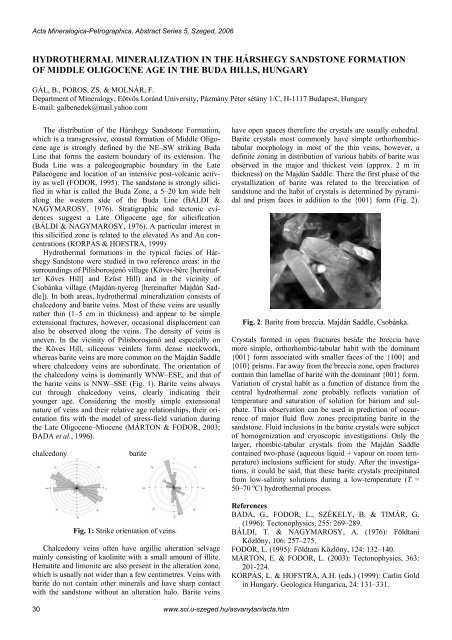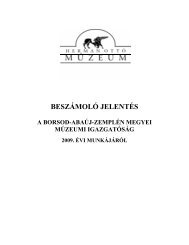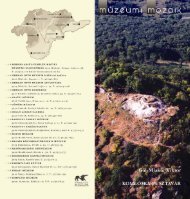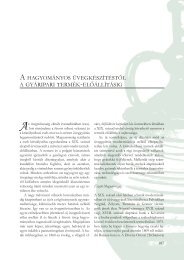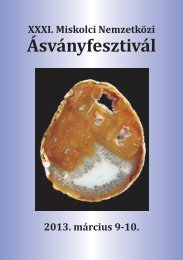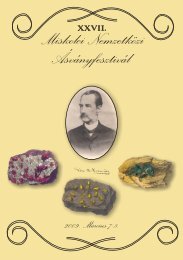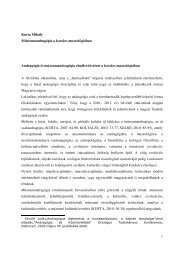Acta Mineralogica-Petrographica, Abstract Series 5, Szeged, 2006HYDRO<strong>THE</strong>RMAL <strong>M<strong>IN</strong>ERAL</strong>IZATION <strong>IN</strong> <strong>THE</strong> HÁRSHEGY SANDSTONE FORMATIONOF MIDDLE OLIGOCENE AGE <strong>IN</strong> <strong>THE</strong> BUDA HILLS, HUNGARYGÁL, B., POROS, ZS. & MOLNÁR, F.Department of Mineralogy, Eötvös Loránd University, Pázmány Péter sétány 1/C, H-1117 Budapest, HungaryE-mail: galbenedek@mail.yahoo.comThe distribution of the Hárshegy Sandstone Formation,which is a transgressive, coastal formation of Middle Oligoceneage is strongly defined by the NE–SW striking BudaLine that forms the eastern boundary of its extension. TheBuda Line was a paleogeographic boundary in the LatePalaeogene and location of an intensive post-volcanic activityas well (FODOR, 1995). The sandstone is strongly silicifiedin what is called the Buda Zone, a 5–20 km wide beltalong the western side of the Buda Line (BÁLDI &NAGYMAROSY, 1976). Stratigraphic and tectonic evidencessuggest a Late Oligocene age for silicification(BÁLDI & NAGYMAROSY, 1976). A particular interest inthis silicified zone is related to the elevated As and Au concentrations(KORPÁS & HOFSTRA, 1999)Hydrothermal formations in the typical facies of HárshegySandstone were studied in two reference areas: in thesurroundings of Pilisborosjenő village (Köves-bérc [hereinafterKöves Hill] and Ezüst Hill) and in the vicinity ofCsobánka village (Majdán-nyereg [hereinafter Majdán Saddle]).In both areas, hydrothermal mineralization consists ofchalcedony and barite veins. Most of these veins are usuallyrather thin (1–5 cm in thickness) and appear to be simpleextensional fractures, however, occasional displacement canalso be observed along the veins. The density of veins isuneven. In the vicinity of Pilisborosjenő and especially onthe Köves Hill, siliceous veinlets form dense stockwork,whereas barite veins are more common on the Majdán Saddlewhere chalcedony veins are subordinate. The orientation ofthe chalcedony veins is dominantly WNW–ESE, and that ofthe barite veins is NNW–SSE (Fig. 1). Barite veins alwayscut through chalcedony veins, clearly indicating theiryounger age. Considering the mostly simple extensionalnature of veins and their relative age relationships, their orientationfits with the model of stress-field variation duringthe Late Oligocene–Miocene (MÁRTON & FODOR, 2003;BADA et al., 1996).chalcedonybariteFig. 1: Strike orientation of veins.Chalcedony veins often have argillic alteration selvagemainly consisting of kaolinite with a small amount of illite.Hematite and limonite are also present in the alteration zone,which is usually not wider than a few centimetres. Veins withbarite do not contain other minerals and have sharp contactwith the sandstone without an alteration halo. Barite veinshave open spaces therefore the crystals are usually euhedral.Barite crystals most commonly have simple orthorhombictabularmorphology in most of the thin veins, however, adefinite zoning in distribution of various habits of barite wasobserved in the major and thickest vein (approx. 2 m inthickness) on the Majdán Saddle. There the first phase of thecrystallization of barite was related to the brecciation ofsandstone and the habit of crystals is determined by pyramidaland prism faces in addition to the {001} form (Fig. 2).Fig. 2: Barite from breccia. Majdán Saddle, Csobánka.Crystals formed in open fractures beside the breccia havemore simple, orthorhombic-tabular habit with the dominant{001} form associated with smaller faces of the {100} and{010} prisms. Far away from the breccia zone, open fracturescontain thin lamellae of barite with the dominant {001} form.Variation of crystal habit as a function of distance from thecentral hydrothermal zone probably reflects variation oftemperature and saturation of solution for barium and sulphate.This observation can be used in prediction of occurrenceof major fluid flow zones precipitating barite in thesandstone. Fluid inclusions in the barite crystals were subjectof homogenization and cryoscopic investigations. Only thelarger, rhombic-tabular crystals from the Majdán Saddlecontained two-phase (aqueous liquid + vapour on room temperature)inclusions sufficient for study. After the investigations,it could be said, that these barite crystals precipitatedfrom low-salinity solutions during a low-temperature (T =50–70 ºC) hydrothermal process.ReferencesBADA, G., FODOR, L., SZÉKELY, B. & TIMÁR, G.(1996): Tectonophysics, 255: 269–289.BÁLDI, T. & NAGYMAROSY, A. (1976): FöldtaniKözlöny, 106: 257–275.FODOR, L. (1995): Földtani Közlöny, 124: 132–140.MÁRTON, E. & FODOR, L. (2003): Tectonophysics, 363:201-224.KORPÁS, L. & HOFSTRA, A.H. (eds.) (1999): Carlin Goldin Hungary. Geologica Hungarica, 24: 131–331.30www.sci.u-szeged.hu/asvanytan/acta.htm
Acta Mineralogica-Petrographica, Abstract Series 5, Szeged, 2006<strong>M<strong>IN</strong>ERAL</strong>OGICAL AND PETROGRAPHIC CHARACTERISTICS OF <strong>THE</strong> XVIITHCENTURY CERAMIC WARE FOUND <strong>IN</strong> <strong>THE</strong> ORADEA FORTRESS (ROMANIA)GHERGARI, L., LAZAR, C. & IONESCU, C.Department of Mineralogy, Babeş-Bolyai University, 1 Kogălniceanu Str., RO-400084 Cluj-Napoca, RomaniaE-mail: ghergari@bioge.ubbcluj.roIn the Medieval fortress of Oradea (west Romania) a highnumber of Medieval archaeological objects were exhumedduring the 2001 archaeological campaign. From these, thebeautiful glazed ceramic ware, archaeologically dated at theXVIIth century, was studied from mineralogical, petrographicand technological point of view. Macroscopically, therecovered material represents either whole household pots orfragments, in general with the surface covered by colouredglaze. From macroscopical point of view, the ceramic fragmentscan be divided into two categories: type A ceramics,with zoned distribution of colours, i.e. a reddish external partand a more brownish-blackish internal part, reflecting thevariable firing atmosphere, from reducing to oxidizing oneand type B ceramics, of homogeneous creamy colour, mirroringa constant, oxidizing, firing atmosphere and Fe-poor rawmaterials.Type A ceramics can be classified mainly as coarse one,with a significant contribution of inclusions larger than0.05 mm. Some vessels show a fine to semifine character.Mineralogically, the composition of the ceramic fragments isquite similar, for all categories of fineness. In the mainlysintered, slightly vitrified matrix, with microcrystallineamorphoustexture, various clasts occur. The crystalloclastsare quartz, plagioclase and alkaline feldspars, micas, andheavy minerals fragments, the lithoclasts are quartzites,gneisses, micaschists, granites, granodiorites, andesites, volcanicglass, sandstones, limestones, and silicastones fragments.The potsherds (ceramoclasts) are rare. The porosity isrelatively low, with irregular-shaped pores, often filled inwith glass. The arrangement of the mica lamellae as well ofthe pores in rows parallel to the surface is ubiquitous. Thisoriented structure is mainly due to the modelling of the wareat the potter’s wheel. The ceramic body is covered by glaze, abrown glassy mass, with a high refractive index, containingprobably Pb-based pigments. Based on the alteration of boththe microscopical features and some XRD lines comparedwith literature data (SHEPARD, 1976; VELDE & DRUC,1999 etc.), we presumed a high firing temperature between850 and 900 °C for type A ceramics. Most likely, illitickaoliniticclays with some calcite content were used as rawmaterials.Type B ceramics has mainly semifine and only subordinatelycoarse character. The ceramic body is composed, microscopically,from a high amount (up to 70%) of transparent,slightly brownish microcrystalline-vitreous matrix and alower amount of clasts (maximum 30%). The matrix containshigh amounts of newly formed glass, as a result of the hightemperature of firing. Quartz, feldspars, micas and heavyminerals fragments form the crystalloclasts, while quartzites,gneisses, quartzitic-biotitic schists, granodiorites, rhyolites,dacites, andesites, silicastones, sandstones and clays form thelithoclasts. The porosity is relatively high and is representedmainly by primary, elongated pores. The structure of theceramic body is clearly oriented, with both lamellae andpores arranged in parallel rows to the surface of the ceramicwall, result of the potter’s wheel modelling. The firing productsare represented by the high amount of glass, the sinteringof the clayish matrix, and the forming of mullite. Based onthe thermal alteration processes noticed in thin sections andX-ray diffractograms, we inferred a high temperature of firing,in the range of 900 to 1000°C. For Type B ceramics mostlikely kaolinitic-illitic clay was used as raw material.This study was financially supported by the RomanianMinistry of Education and Research (Grant 1762/2005).ReferencesSHEPARD, A.O. (1976): Ceramics for the archaeologist. 7 thed. Washington: Carnegie Institution of Washington, 414p.VELDE, B. & DRUC, I.C. (1999): Archaeological ceramicmaterials. Berlin: Springer, 299 p.www.sci.u-szeged.hu/asvanytan/acta.htm 31
- Page 1: MSCC33 rd MINERAL SCIENCES IN THE C
- Page 5 and 6: Acta Mineralogica-Petrographica, Ab
- Page 7 and 8: Acta Mineralogica-Petrographica, Ab
- Page 9 and 10: Acta Mineralogica-Petrographica, Ab
- Page 11 and 12: Acta Mineralogica-Petrographica, Ab
- Page 13 and 14: Acta Mineralogica-Petrographica, Ab
- Page 15 and 16: Acta Mineralogica-Petrographica, Ab
- Page 17 and 18: Acta Mineralogica-Petrographica, Ab
- Page 19 and 20: Acta Mineralogica-Petrographica, Ab
- Page 21 and 22: Acta Mineralogica-Petrographica, Ab
- Page 23 and 24: Acta Mineralogica-Petrographica, Ab
- Page 25 and 26: Acta Mineralogica-Petrographica, Ab
- Page 27 and 28: Acta Mineralogica-Petrographica, Ab
- Page 29: Acta Mineralogica-Petrographica, Ab
- Page 33 and 34: Acta Mineralogica-Petrographica, Ab
- Page 35 and 36: Acta Mineralogica-Petrographica, Ab
- Page 37 and 38: Acta Mineralogica-Petrographica, Ab
- Page 39 and 40: Acta Mineralogica-Petrographica, Ab
- Page 41 and 42: Acta Mineralogica-Petrographica, Ab
- Page 43 and 44: Acta Mineralogica-Petrographica, Ab
- Page 45 and 46: Acta Mineralogica-Petrographica, Ab
- Page 47 and 48: Acta Mineralogica-Petrographica, Ab
- Page 49 and 50: Acta Mineralogica-Petrographica, Ab
- Page 51 and 52: Acta Mineralogica-Petrographica, Ab
- Page 53 and 54: Acta Mineralogica-Petrographica, Ab
- Page 55 and 56: Acta Mineralogica-Petrographica, Ab
- Page 57 and 58: Acta Mineralogica-Petrographica, Ab
- Page 59 and 60: Acta Mineralogica-Petrographica, Ab
- Page 61 and 62: Acta Mineralogica-Petrographica, Ab
- Page 63 and 64: Acta Mineralogica-Petrographica, Ab
- Page 65 and 66: Acta Mineralogica-Petrographica, Ab
- Page 67 and 68: Acta Mineralogica-Petrographica, Ab
- Page 69 and 70: Acta Mineralogica-Petrographica, Ab
- Page 71 and 72: Acta Mineralogica-Petrographica, Ab
- Page 73 and 74: Acta Mineralogica-Petrographica, Ab
- Page 75 and 76: Acta Mineralogica-Petrographica, Ab
- Page 77 and 78: Acta Mineralogica-Petrographica, Ab
- Page 79 and 80: Acta Mineralogica-Petrographica, Ab
- Page 81 and 82:
Acta Mineralogica-Petrographica, Ab
- Page 83 and 84:
Acta Mineralogica-Petrographica, Ab
- Page 85 and 86:
Acta Mineralogica-Petrographica, Ab
- Page 87 and 88:
Acta Mineralogica-Petrographica, Ab
- Page 89 and 90:
Acta Mineralogica-Petrographica, Ab
- Page 91 and 92:
Acta Mineralogica-Petrographica, Ab
- Page 93 and 94:
Acta Mineralogica-Petrographica, Ab
- Page 95 and 96:
Acta Mineralogica-Petrographica, Ab
- Page 97 and 98:
Acta Mineralogica-Petrographica, Ab
- Page 99 and 100:
Acta Mineralogica-Petrographica, Ab
- Page 101 and 102:
Acta Mineralogica-Petrographica, Ab
- Page 103 and 104:
Acta Mineralogica-Petrographica, Ab
- Page 105 and 106:
Acta Mineralogica-Petrographica, Ab
- Page 107 and 108:
Acta Mineralogica-Petrographica, Ab
- Page 109 and 110:
Acta Mineralogica-Petrographica, Ab
- Page 111 and 112:
Acta Mineralogica-Petrographica, Ab
- Page 113 and 114:
Acta Mineralogica-Petrographica, Ab
- Page 115 and 116:
Acta Mineralogica-Petrographica, Ab
- Page 117 and 118:
Acta Mineralogica-Petrographica, Ab
- Page 119 and 120:
Acta Mineralogica-Petrographica, Ab
- Page 121 and 122:
Acta Mineralogica-Petrographica, Ab
- Page 123 and 124:
Acta Mineralogica-Petrographica, Ab
- Page 125 and 126:
Acta Mineralogica-Petrographica, Ab
- Page 127 and 128:
Acta Mineralogica-Petrographica, Ab
- Page 129 and 130:
Acta Mineralogica-Petrographica, Ab
- Page 131 and 132:
Acta Mineralogica-Petrographica, Ab
- Page 133 and 134:
Acta Mineralogica-Petrographica, Ab


